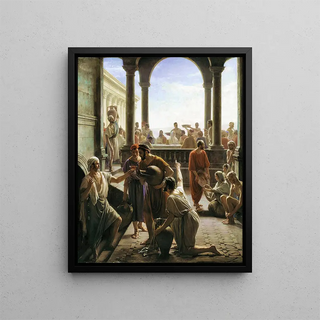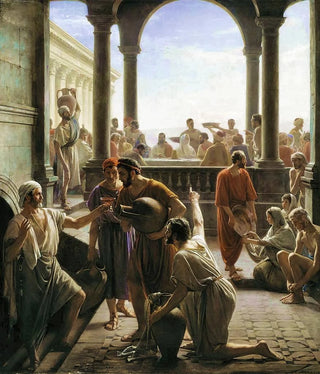Painting Transformer l'eau en vin - Carl Bloch | Art print


View from behind

Frame (optional)
Transform the water into wine - Carl Bloch – Captivating introduction
In the fascinating universe of sacred art, the artwork "Transform the water into wine" by Carl Bloch stands out for its emotional depth and bold interpretation of a biblical miracle. This painting, which evokes the famous scene of the wedding at Cana, transports the viewer to a pivotal moment in Christ's life, where he transforms water into wine, a symbol of joy and celebration. The artist, through his skill in capturing light and human expressions, invites everyone to contemplate not only the miracle but also the spiritual and human dimension of this event. The art print of this piece allows for appreciation of every detail, every nuance of color, paying homage to Carl Bloch's virtuosity and his ability to tell stories through painting.
Style and uniqueness of the work
Carl Bloch's style is characterized by striking realism and meticulous attention to detail. In "Transform the water into wine," he manages to create a vibrant, almost tangible atmosphere, where the characters seem to come alive under the viewer's gaze. Expressive faces, the richness of drapery, and the soft light flooding the scene all testify to exceptional craftsmanship. Bloch uses warm tones that evoke a sense of closeness and intimacy, making the scene accessible and emotionally engaging. Each character, whether an apostle or a guest, is depicted with such precision that they seem to tell their own story. This marriage of the sacred and the human, between the divine and everyday life, gives the artwork a singularity that continues to captivate art lovers and spirituality enthusiasts.
The artist and his influence
Carl Bloch, Danish painter of the 19th century, is recognized for his talent in depicting religious scenes with rare psychological depth. His European training, combined with his attachment to Scandinavian culture, allowed him to develop a style that blends tradition and innovation. Influenced by the great masters of painting, Bloch was able to incorporate elements of Romanticism and realism, creating a work that transcends eras. His impact on sacred art is undeniable, and

Matte finish

View from behind

Frame (optional)
Transform the water into wine - Carl Bloch – Captivating introduction
In the fascinating universe of sacred art, the artwork "Transform the water into wine" by Carl Bloch stands out for its emotional depth and bold interpretation of a biblical miracle. This painting, which evokes the famous scene of the wedding at Cana, transports the viewer to a pivotal moment in Christ's life, where he transforms water into wine, a symbol of joy and celebration. The artist, through his skill in capturing light and human expressions, invites everyone to contemplate not only the miracle but also the spiritual and human dimension of this event. The art print of this piece allows for appreciation of every detail, every nuance of color, paying homage to Carl Bloch's virtuosity and his ability to tell stories through painting.
Style and uniqueness of the work
Carl Bloch's style is characterized by striking realism and meticulous attention to detail. In "Transform the water into wine," he manages to create a vibrant, almost tangible atmosphere, where the characters seem to come alive under the viewer's gaze. Expressive faces, the richness of drapery, and the soft light flooding the scene all testify to exceptional craftsmanship. Bloch uses warm tones that evoke a sense of closeness and intimacy, making the scene accessible and emotionally engaging. Each character, whether an apostle or a guest, is depicted with such precision that they seem to tell their own story. This marriage of the sacred and the human, between the divine and everyday life, gives the artwork a singularity that continues to captivate art lovers and spirituality enthusiasts.
The artist and his influence
Carl Bloch, Danish painter of the 19th century, is recognized for his talent in depicting religious scenes with rare psychological depth. His European training, combined with his attachment to Scandinavian culture, allowed him to develop a style that blends tradition and innovation. Influenced by the great masters of painting, Bloch was able to incorporate elements of Romanticism and realism, creating a work that transcends eras. His impact on sacred art is undeniable, and
12,34 €






